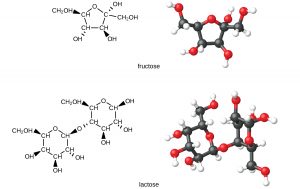Introduction to Carbohydrates
In Chapter 4, we were introduced to the three main biomolecules of a human diet and their caloric contents: carbohydrates, fats, and proteins. In this chapter, we will investigate one of these three types of biomolecules: carbohydrates.
Examples of carbohydrates include starch, fiber, the sweet-tasting compounds called sugars, and structural materials such as cellulose. The dietary forms of carbohydrates are foods rich in these types of molecules, like pastas, bread, and candy.
All carbohydrates consist of carbon, hydrogen, and oxygen atoms. The name “carbohydrate” comes from the formula of the molecules, which can be described by the general formula Cm(H2O)n, which shows that they are in a sense “carbon and water” or “hydrates of carbon.” In many cases, m and n have the same value, but they can be different. The smaller carbohydrates are generally referred to as “sugars,” the biochemical term for this group of molecules is “saccharide” from the Greek word for sugar. Depending on the number of sugar units joined together, they may be classified as monosaccharides (one sugar unit), disaccharides (two sugar units), oligosaccharides (a few sugars), or polysaccharides (many sugars). The scientific names of sugars can be recognized by the suffix -ose at the end of the name (for instance, fruit sugar is a monosaccharide called “fructose” and milk sugar is a disaccharide called “lactose”).

Carbohydrates and Photosynthesis
Green plants are capable of synthesizing glucose (C6H12O6) from carbon dioxide (CO2) and water (H2O) by using solar energy in the process known as photosynthesis:
6 CO2 + 6 H2O + 686 kcal → C6H12O6 + 6 O2
(The 686 kcal come from solar energy.) Plants can use the glucose for energy or convert it to larger carbohydrates, such as starch or cellulose. Starch provides energy for later use, perhaps as nourishment for a plant’s seeds, while cellulose is the structural material of plants. We can gather and eat the parts of a plant that store energy—seeds, roots, tubers, and fruits—and use some of that energy ourselves. Animals, including humans, cannot synthesize carbohydrates from carbon dioxide and water and are therefore dependent on the plant kingdom to provide these vital compounds.
Uses of Carbohydrates
We use carbohydrates not only for food (about 60%–65% by mass of the average diet) but also for clothing (cotton, linen, rayon), shelter (wood), fuel (wood), and paper (wood). Like plants, we can store energy in the form of the polysaccharide glycogen (which we will see later is similar to starch). Some animals and fungi use a modified polysaccharide called chitin for structural support in their bodies. Lastly, sugars play key roles in the function of the immune system, in cell-cell recognition, and the synthesis of nucleic acids (DNA and RNA), proteins and lipids.
Naming and Classifying Carbohydrates
The simplest carbohydrates—those that cannot be broken down to produce even smaller carbohydrates—are called monosaccharides. Two or more monosaccharides can link together to form chains that contain anywhere from two to several hundred or thousand monosaccharide units. Prefixes are used to indicate the number of such units in the chains. Disaccharide molecules have two monosaccharide units, trisaccharide molecules have three units, and so on. Chains with many monosaccharide units joined together are called polysaccharides. All these so-called higher saccharides can be broken down into their constituent monosaccharides. We break down higher saccharides into individual monosaccharides when we digest carbohydrates.
The process of breaking down higher saccharides into smaller units is called hydrolysis. The suffix -lysis means “to break apart.” Thus, hydrolysis indicates a reaction where water reacts with a larger molecule, breaking it into smaller units. Carbohydrates that cannot be hydrolyzed will not react with water to form two or more smaller compounds are called monosaccharides.
Concept Review Exercises
- Why is photosynthesis important?
- Identify the differences among monosaccharides, disaccharides, and polysaccharides.
Solutions
- Photosynthesis is the process by which solar energy is used to reduce carbon dioxide to carbohydrates, which are needed for energy by plants and other living organisms that eat plants.
- A monosaccharide is the simplest carbohydrate and cannot be hydrolyzed to produce a smaller carbohydrate; a disaccharide is composed of two monosaccharide units; and a polysaccharide contains many saccharide units.
Attributions
This page is based on “Chemistry 2e” by Paul Flowers, Klaus Theopold, Richard Langley, William R. Robinson, PhD, Openstax which is licensed under CC BY 4.0. Access for free at https://openstax.org/books/chemistry-2e/pages/1-introduction
This page is based on “The Basics of General, Organic, and Biological Chemistry” by David W Ball, John W Hill, Rhonda J Scott, Saylor which is licensed under CC BY-NC-SA 4.0. Access for free at http://saylordotorg.github.io/text_the-basics-of-general-organic-and-biological-chemistry/index.html

